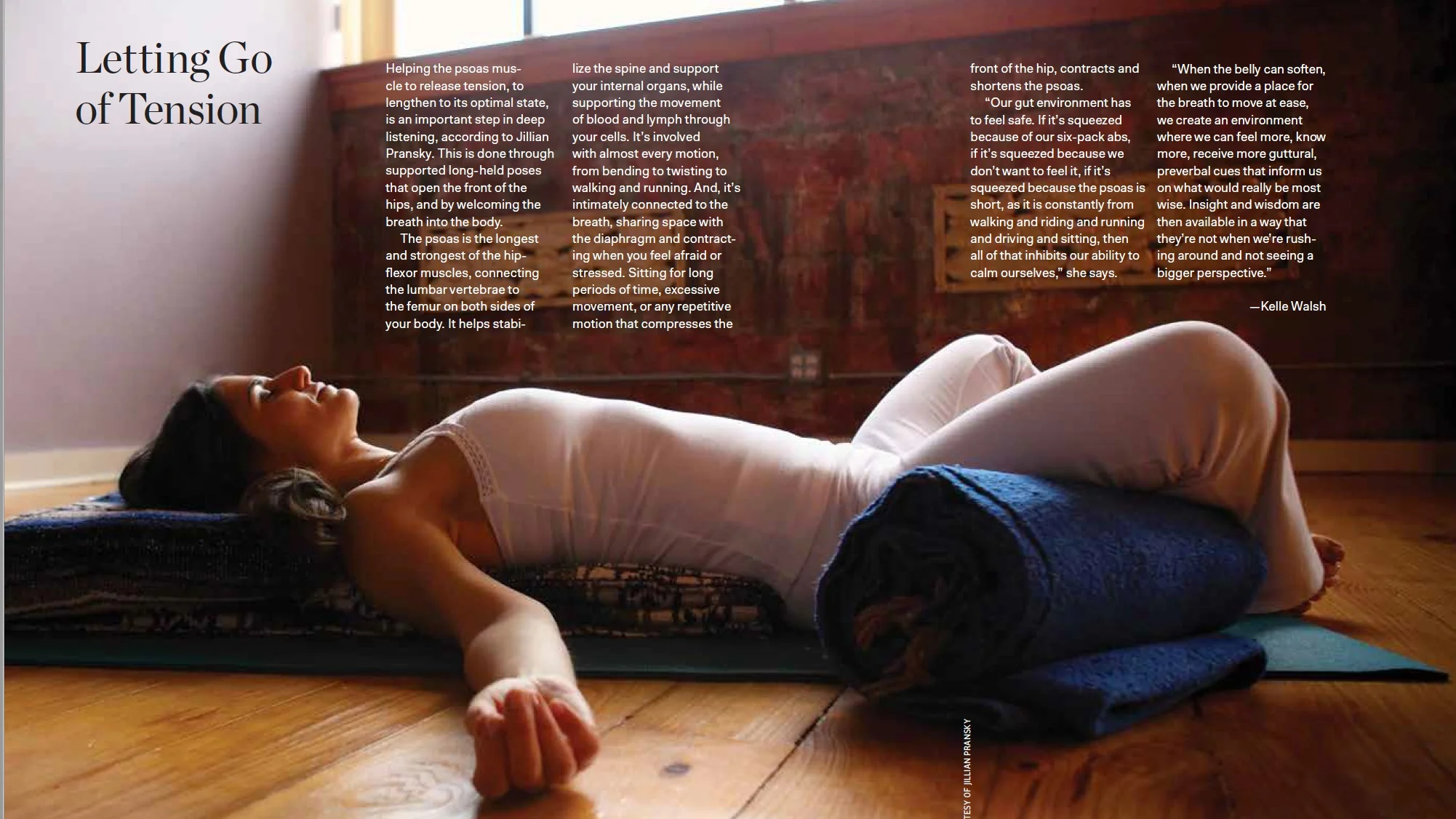Welcome! It’s safe to land here.
/I recently had the opportunity to share Restorative Yoga with Mindful Magazine's Senior Editor, Kelle Walsh.
After our session we sat down to talk about -- the healing conditions that we cultivate for our body, mind and spirit - when we allow our bodies to be held, completely, by the support that is underneath our body and allow our breath to flow freely through us.
This meeting turned into a featured article in this month's Issue of Mindful Magazine. Here is just a short teaser of a deep and beautiful exploration of the practice that Kelle shares from her own experience.
The Magazine is available on newsstands all this month, and visit Mindful.org to practice a free soft belly breathing meditation with me.
Full Excerpt from Article by Kelle Walsh:
I’m not normally so observant of my breath. But I’m following Jillian Pransky’s voice, a bit raspy, slow and clear and incredibly relaxing. She’s guiding me through her signature Deep Listening practice, which, in this moment, I could honestly describe as liquefying. As in, it feels like my muscles have separated from my bones and both are suspended in some viscous substance, my mind contentedly floating alongside.
I’ve come to meet Pransky to experience her body-based relaxation system that blends yoga, mindfulness, and somatic awareness into a delicious low-tech stew—a nourishing and welcome response to our hyper-connected and overstimulated lives. It might just be the antithesis of popular modern yoga styles—no overheated room, no endless Chaturangas-to-Up-Dog vinyasas, no orders to inhale! exhale!
The more familiar we are with how and where we hold tension, the easier it is to notice “how we are closing down or opening up to the current conditions in our lives,” Pransky says.
Whether we consciously choose to hold tension or our bodies and minds do it for us, when we do, Pransky says, we feel in control. “When we relax, we feel vulnerable.”
Tension becomes our armor, holding the fear, worry, and vulnerability at bay. But eventually, inevitably, it fails us. With stress hormones coursing through our bloodstream, as we hold ourselves so tightly to stay “safe” that we forget to take a deep breath, we’re just one fender bender, one work crisis, one sad and senseless loss away from falling apart. That’s when we get sick. Or stop sleeping through the night. Or blow our stack at someone we love, or suffer a panic attack and become afraid to live our lives.
Before we can release tension, however, we have to know where we hold it. And it’s not always obvious where it resides, Pransky says. “We’re so used to living with it, we think we are relaxed while, in fact, we are still harboring tension.”
Lying with my head and back supported by a bolster, my mind idly following my breath as it moves through my limp body, I’m suddenly aware of a sensation of opening deep in my core, and something seems to shift within. As my breath sinks into this new space, I feel a sense of sadness. I feel how weary I am. I’ve been traveling for almost two weeks, and it’s been emotional, visiting with older family members and coming face-to-face with how much has changed, and how much more change is still to come. I’ve spent hours on planes and trains and in cars, and I haven’t done any yoga or much exercise at all. I’m ready to go home, but some things there too are uncertain. I miss my dog.
“Just welcome the breath,” Pransky is saying, and as the emotions fill me, I’m grateful for this guidance. I touch the sadness lightly with my breath, exploring its shape and size, its texture and density. After what could be a few moments or an hour, it starts to grow lighter, thinner, and more transparent, until...it’s gone. I feel lighter, my mind suddenly alert, yet my body is still deeply relaxed.
Wow.
This experience is why Pransky is a proponent of pairing mindfulness with somatic awareness. When we engage in restorative poses, opening the anatomy and welcoming the breath deeply into the body, we not only trigger the relaxation response, we uncover those deeper areas of tightness and holding. And as we just notice, just rest, just listen, we offer ourselves a great kindness that makes us feel cared for. “It sends our mind a signal that right now, in this moment, we’re OK,” she says.
She describes it like a plane coming in for a landing. Before the plane can touch down, the pilot needs to receive a message: “Welcome! It’s safe to land here.”
Having the embodied sense of being supported by the ground, of being safe in our own bodies, we can start to lay down the armor of tension. “And our mind can begin to shift into a new conversation: ‘I’m OK here on the ground.’”
This is where Deep Listening becomes a tool for life. We’re building resilience “over time, making more space and capacity to stay open with whatever arises.”
Please pick up a copy of the May/June Issue of Mindful Magazine to read the full article. And try the Soft Belly Breathing Exercise on Mindful.org.






